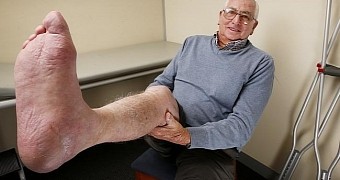Prosthetics have been one of the major beneficiaries of 3D printing technology, but the best thing would be to not need prosthetic legs or arms at all, and it appears that 3D printing can help here as well.
It might sound a bit paradoxical, but it is in fact perfectly in line with the essentially unlimited applications of additive manufacturing.
Especially when you factor in how much attention 3D printed implants and joint replacements and the like have been getting lately. Bone substitutes are one of the biggest successes of the field.
As it happens, a bone substitute is exactly what we're going to talk about. One that essentially saved the life of a man from Australia.
The 3D printed replacement heel
Maybe it's a bit of an exaggeration to say that the 3D printed heel saved the man's life, since he wouldn't have perished in absence of the option.
However, it's one thing to live your life freely and another to just get by, to survive under restrictive and painful conditions.
From that perspective, the replacement heel did save the man's life, since it eliminated the prospect of a life without his right limb.
Len Chandler, aged 71, suffered from cartilage cancer and would normally have had his foot amputated. However, Professor Peter Choong, surgeon at St. Vincent’s Hospital in Melbourne, had an alternative.
After learning about the man's plight, he came up with a design for a heel bone print that would replace the real heel bone, which was where the tumor had grown.
The calcaneus is the technical term, the large bone that plays the role of foundation for the back of the foot and connects with both the cuboid and talus bones. The Achilles tendon is attached to it.
Said tendon should attach to the new heel well enough. Chandler can already put half his weight on the foot again. A great alternative to losing his leg from below the knee.
How it went down
Chandler's perfectly healthy left foot was scanned first, then the right one, after which the data was sent to Anatomics, an implant maker from Melbourne. The design was then created for a new heel bone, after which an Arcam 3D printer produced it from titanium.
In truth, heel cancer is a pretty rare thing to see. But that only means that there is even more incentive to come up with standard 3D printed implant procedures for the more common conditions that would otherwise result in an amputation.

 14 DAY TRIAL //
14 DAY TRIAL //